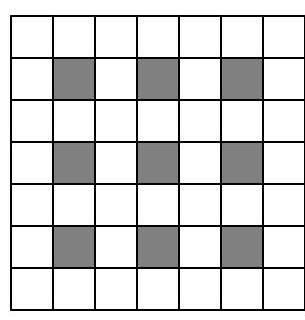Appearance
question:A continuous function f : R to R satisfies the conditions f(1000) = 999 and f(x)f(f(x)) = 1 for all real x. Determine f(500).
answer:1. Given the function ( f : mathbb{R} to mathbb{R} ) is continuous and satisfies the conditions ( f(1000) = 999 ) and ( f(x)f(f(x)) = 1 ) for all real ( x ).2. From the condition ( f(x)f(f(x)) = 1 ), we can derive: [ f(f(x)) = frac{1}{f(x)} ]3. We need to determine ( f(500) ). To do this, we will show that there exists some ( t in mathbb{R} ) such that ( f(t) = 500 ).4. Assume for contradiction that ( f(x) < 500 ) for all ( x in mathbb{R} ). This would imply that ( f(1000) = 999 ) is a contradiction because ( 999 > 500 ). Therefore, ( f(x) < 500 ) for all ( x in mathbb{R} ) is not possible.5. Similarly, assume for contradiction that ( f(x) > 500 ) for all ( x in mathbb{R} ). Then, from ( f(f(x)) = frac{1}{f(x)} ), we would have: [ f(f(x)) < frac{1}{500} ] This would imply that ( f(f(x)) ) is always less than ( frac{1}{500} ). However, since ( f ) is continuous and ( f(1000) = 999 ), this would again lead to a contradiction because ( f(f(1000)) = f(999) ) should be greater than ( frac{1}{500} ).6. Since both assumptions lead to contradictions, there must exist some ( t in mathbb{R} ) such that ( f(t) = 500 ).7. Let ( x = t ). Then: [ f(500) = frac{1}{500} ]The final answer is ( boxed{frac{1}{500}} ).
question:For any real number x, [x] represents the greatest integer not exceeding x, and {x} represents the fractional part of x. Thenleft{frac{2014}{2015}right}+left{frac{2014^{2}}{2015}right}+cdots+left{frac{2014^{2014}}{2015}right}=
answer:-1.1007.Notice that,frac{2014^{n}}{2015}=frac{(2015-1)^{n}}{2015}=M+frac{(-1)^{n}}{2015},where M is an integer.Then left{frac{2014^{n}}{2015}right}=left{begin{array}{ll}frac{1}{2015}, & n text { is even; } frac{2014}{2015}, & n text { is odd. }end{array}right.Therefore, the original expression =1007.
question:9. (1990 Hungarian Mathematical Olympiad) For any positive integer q_{0}, consider the sequence q_{1}, q_{2}, cdots, q_{n} defined by q_{i}=left(q_{i-1}-1right)^{3}+ 3(i=1,2, cdots, n). If each q_{i}(i=1,2, cdots, n) is a prime, find the largest possible value of n.
answer:9. Since m^{3}-m=m(m-1)(m+1) equiv 0(bmod 3), we haveq_{i}=left(q_{i-1}-1right)^{3}+3 equivleft(q_{i-1}-1right)^{3} equiv q_{i-1}-1(bmod 3) text {. }Therefore, among q_{1}, q_{2}, q_{3}, there must be one that is divisible by 3, and this number should be a power of 3.If 3 mid(q-1)^{3}+3, then 3 mid(q-1)^{3}, so 3 mid q-1.Hence, 3^{3} mid(q-1)^{3}.And since 3 mid(q-1)^{3}+3,it follows that left(q_{i}-1right)^{3}+3 is a power of 3 only when q_{i}=1, which must occur when i=0.However, when q_{0}=1, we getq_{1}=3, q_{2}=11, q_{3}=1003=17 cdot 59 text {. }Thus, the maximum value of n is 2.
question:The function f(x)=cos (omega x+ frac{pi}{3}) (omega > 0) within the interval [0,pi] has the range [-1, frac{1}{2}], then the range of omega is (quad)A: [frac{3}{2}, frac{5}{3}]B: [frac{2}{3}, frac{4}{3}]C: [frac{2}{3},+infty]D: [frac{2}{3}, frac{3}{2}]
answer:AnalysisThis question examines the graph and properties of trigonometric functions. According to the problem, we have omega x+ frac{pi}{3}in[frac{pi}{3},omegapi+ frac{pi}{3}]. Since the range of the function f(x) is [-1, frac{1}{2}], it follows that pileqslant omegapi+ frac{pi}{3}leqslant frac{5}{3}pi, from which the result can be derived.SolutionGiven: xin[0,pi],Thus, omega x+ frac{pi}{3}in[frac{pi}{3},omegapi+ frac{pi}{3}],Since the range of the function f(x) is [-1, frac{1}{2}],It follows that pileqslant omegapi+ frac{pi}{3}leqslant frac{5}{3}pi, solving this yields frac{2}{3}leqslant omegaleqslant frac{4}{3}.Therefore, the correct choice is boxed{text{B}}.
question:Problem 5. An archipelago consists of several small islands and one large island. It was decided to build bridges between the islands so that the large island would be connected to each small island by two bridges, and any two small islands would be connected by one bridge.By November 1, all the bridges between the small islands and several (at least one) bridges leading to the large island - a total of 28 bridges - had been built. How many islands are there in the archipelago?Answer: 8 islands
answer:Solution. Let's number the small islands of the archipelago. If a bridge connects islands with numbers a and b, we write the smaller of these two numbers on this bridge.Suppose the number of small islands in the archipelago is no more than six. Then there are no more than 5 bridges with the number 1, no more than 4 bridges with the number 2, and so on. No more than 12 bridges lead to the large island. Therefore, the total number of bridges built is no more than5+4+3+2+1+12=2728which also contradicts the condition.Thus, there are 7 small islands in the archipelago, and a total of 8 islands.## Criteria4 points. A complete and justified solution is provided.06 . The problem is not solved or solved incorrectly.In other cases, sum the following criteria (but do not exceed 4 points):2 points. It is proven that the number of islands is no more than eight (if there is an arithmetic error in the proof, then 16 .)2 6. It is proven that the number of islands is no less than eight (if there is an arithmetic error in the proof, then 1 point).16 . The correct answer is provided.
question:11 If log _{4}(x+2 y)+log _{4}(x-2 y)=1, then the minimum value of |x|-|y| is qquad .
answer:Solution: First, fromleft{begin{array}{l}x + 2 y > 0, x - 2 y > 0, (x + 2 y)(x - 2 y) = 4end{array} text { we get } quad left{begin{array}{l}x > 2|y| geqslant 0, x^{2} - 4 y^{2} = 4 .end{array}right.right.By symmetry, we only need to consider the case when y geqslant 0. Since x > 0, we only need to find the minimum value of x - y.Let u = x - y, substitute into x^{2} - 4 y^{2} = 4, we get3 y^{2} - 2 u y + (4 - u^{2}) = 0,For the equation (*) to have real solutions for y, we haveDelta = 4 u^{2} - 12(4 - u^{2}) geqslant 0,Thus,u geqslant sqrt{3}.Furthermore, when x = frac{4}{3} sqrt{3}, y = frac{sqrt{3}}{3}, we have u = sqrt{3}.Therefore, the minimum value of |x| - |y| is sqrt{3}.